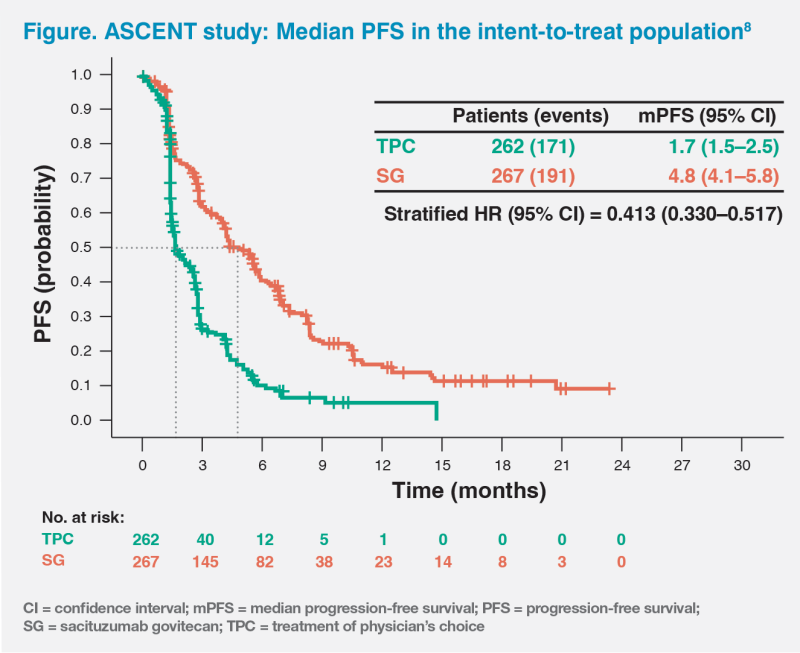Optimizing mTNBC outcomes with a Trop-2–directed ADC: Clinical case perspectives





Case 1: Dose optimization of second-line ADC in an elderly patient with mTNBC after progression on first-line chemo-immunotherapy
A 70-year-old woman with stage 2A triple-negative breast cancer (TNBC; pT1cN1a) and excellent performance status (PS) underwent left total mastectomy followed by adjuvant chemotherapy. Genetic testing revealed no germline BRCA1/2 mutations. Three years later, she developed neck and upper limb swelling. Left neck biopsy confirmed triple-negative metastatic disease with PD-L1 combined positive score (CPS) >75. She received weekly paclitaxel and pembrolizumab, achieving a good response. After 21 cycles (approximately 1.5 years), she developed a sternal nodule, which was surgically excised; pathology indicated triple-negative grade 3 invasive carcinoma with extensive lymphovascular invasion. Molecular testing showed no targetable mutations.
One month after surgery, she developed painful skin nodules around the resection margin and left cervical adenopathy, indicating disease progression. She was started on sacituzumab govitecan (SG) at 10 mg/kg once weekly on days 1 and 8 of each 21-day cycle, with prophylactic antiemetics and antihistamines. She developed grade 4 neutropenia, which was managed with granulocyte-colony stimulating factor (G-CSF) and SG dose reduction to 7.5 mg/kg. The patient experienced mild mucositis and body aches. No gastrointestinal toxicity was reported. The reduced dose was maintained, and her skin nodules remained stable and were no longer painful. Cervical adenopathy also remained stable in size, and breaks in chemotherapy were allowed for holidays. Her disease remained stable for 9 months, before eventual progression was noted with new skin and nodal metastases.
Case 2: Trop-2–directed ADC use in mTNBC with CNS-limited progression and leptomeningeal disease after first-line immunotherapy
A 59-year-old woman diagnosed with stage IA, oestrogen receptor (ER)+ (5 percent weak), progesterone receptor (PR)-, HER2-null invasive ductal carcinoma (pT1cN0) underwent left wide local excision, adjuvant chemotherapy and radiotherapy, and was lost to follow-up. Six years later, she relapsed with mediastinal and supraclavicular lymphadenopathy. Biopsy confirmed TNBC with PD-L1 CPS of 55, and molecular testing revealed no BRCA mutations. She received weekly paclitaxel plus pembrolizumab for 12 weeks, achieving complete response, and was maintained on pembrolizumab.
Six months later, she developed neurological symptoms. MRI revealed multiple brain metastases with leptomeningeal involvement but no extracra-nial disease. She received whole-brain radiotherapy (WBRT) with steroids but deteriorated acutely, requiring ventriculoperitoneal shunt after one fraction for tonsillar herniation. After completing five fractions, her PS was poor. She was started on SG at 10 mg/kg on days 1 and 8 every 21 days. After three cycles of SG, MRI showed a marked intracra-nial response, and steroids were discontinued. Despite limited progression in the brain after five cycles, she remained asymptomatic and received stereotactic radiation. After eight cycles of SG, MRI brain showed clearance of metastases. As of September 2025, she has completed 14 cycles of SG, is able to walk without assistance, and has been alive for >1 year since TNBC diagnosis.
Discussion
TNBC is a biologically aggressive disease, with a high recurrence rate and a propensity for central nervous system (CNS) and visceral metastases. In the metastatic setting, survival outcomes are poorer than for hormone receptor (HR)+/HER2- and HER2+ subtypes, with median overall survival (OS) of approximately 18–19 months.1 First-line pembrolizumab plus chemotherapy is shown to improve response rates, progression-free survival (PFS) and OS vs chemotherapy among patients with PD-L1–positive disease. However, this group of patients make up only 40 percent of metastatic TNBC (mTNBC) patients and are hence eligible for this treatment.2 While germline BRCA1/2 mutations, which are potentially treatable with PARP inhibitors, are present in up to 10 percent of TNBC cases, the majority of patients lack targetable alterations.1,3 Consequently, biomarker-negative patients have very limited treatment options, having to rely on sequential chemotherapy, which is associated with lower response rates and shorter PFS vs targeted therapy. This underscores the urgent need for more effective therapies.1
SG, an antibody-drug conjugate (ADC) targeting Trop-2, a protein broadly expressed in TNBC, is approved for mTNBC treatment in the second line and beyond, regardless of biomarker status.4 Major clinical guidelines, including the European Society for Medical Oncology (ESMO) and the National Comprehensive Cancer Network (NCCN), recommend SG in this setting based on robust efficacy data demonstrated in clinical trials and real-world practice.5,6
In the pivotal phase III ASCENT trial involving 468 patients with relapsed or refractory mTNBC, SG demonstrated superior efficacy vs treatment of physician’s choice (TPC), with overall response rates of 35 vs 5 percent, median PFS of 4.8 vs 1.7 months (hazard ratio, 0.413; 95 percent confidence interval [CI], 0.330–0.517), and median OS of 11.8 vs 6.9 months (hazard ratio, 0.51; 95 percent CI, 0.42–0.63).7,8 (Figure) SG’s effectiveness has also been confirmed in real-world studies, with a nationwide database analysis (n=381) reporting median OS of 11.3 months and 12- and 24-month OS rates of 47 and 19 percent, respectively.9

SG is generally well tolerated with proactive and supportive care. The most clinically relevant adverse events (AEs) are neutropenia and diarrhoea. In ASCENT, rates of grade ≥3 neutropenia (51 vs 33 percent) and diarrhoea (10 vs <1 percent) were higher with SG vs TPC, but rates of treatment discontinuation due to serious AEs were low and comparable (5 percent in both arms), highlighting SG’s tolerability when appropriately managed.7 Neutropenia can be effectively managed with dose reductions, dose delays and prophylactic or reactive G-CSF support.10 Diarrhoea, which is often cholinergic in nature, can be mitigated with dose reductions and prophylactic or reactive loperamide; atropine for severe cholinergic reactions is rarely needed.11
Based on its proven efficacy and favourable tolerability, SG was used in both of our patients who progressed on first-line pembrolizumab plus chemotherapy. In the elderly patient (case 1), SG was effective and well tolerated with appropriate prophylaxis and careful AE management. Neutropenia was managed with reactive G-CSF support, and treatment efficacy was maintained despite dose reduction. Her PFS of 9 months was consistent with ASCENT data, which showed similar outcomes with dose reductions or interruptions compared with the overall population.11
SG also demonstrated efficacy in our patient with brain metastases and leptomeningeal disease (case 2). Early data suggest that SG may cross the blood-brain barrier, with real-world reports indicating CNS response rates of 13.3 percent (n=4/30) in patients with brain metastases and 28.6 percent (n=2/7) in patients with leptomeningeal involvement, despite extensive pretreatment.12,13
Our two cases illustrate SG’s benefit and tolerability for elderly patients and those with CNS involvement in the challenging setting of mTNBC. Tailored approaches for special populations — such as comprehensive geriatric assessments for elderly patients and integration of local therapies and multidisciplinary management for patients with brain metastases — remain essential to optimize outcomes.